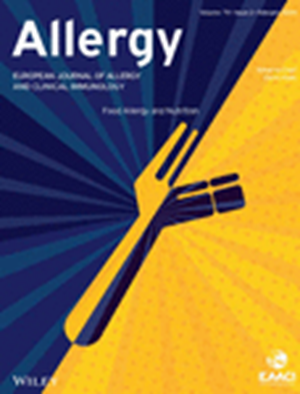HLA-A*02:01提出青霉素修饰的半胱氨酸化肽用于T细胞识别。
IF 12
1区 医学
Q1 ALLERGY
引用次数: 0
摘要
背景:一部分患者对β-内酰胺类抗生素有免疫介导的超敏反应,其中药物特异性T细胞可能是致病因素之一。主要机制被认为涉及自肽的化学半抗原化,导致可能触发T细胞识别的新型肽药物加合物。了解β-内酰胺药物、T细胞受体(TCR)和肽/人白细胞抗原(pHLA)复合物之间的相互作用对于进一步了解这些超敏反应的机制至关重要。本研究旨在1)探索HLA- a *02:01所呈现的半抗原配体阵列,2)评估在过敏患者中参与青霉素诱导反应的T细胞库,3)确定青霉素特异性TCR克隆型是否能识别半抗原化的HLA肽。方法应用免疫肽组学方法鉴定HLA-A*02:01配体中青霉素修饰的肽配体。通过对BP存在下扩增的CD8+ T细胞进行单细胞测序来分析药物反应性TCR库,并在报告细胞系中检测显性TCR的反应性。结果我们报道BP在HLA-A*02:01免疫肽丘中优先修饰半胱氨酸而不是赖氨酸残基。这种修饰通过半胱氨酸-药物偶联物形成,与二硫化物介导的肽修饰一起发生,这在药物过敏的背景下以前没有被考虑过。此外,我们证明了从患者扩增的bp特异性TCR对还原敏感表位起反应,这与T细胞表位内与半胱氨酸残基连接的bp -半胱氨酸加合物二硫化物一致。结论本研究证明半胱氨酸-青霉素加合物可被HLA配体调节,具有诱导T细胞介导的过敏反应的潜力。本文章由计算机程序翻译,如有差异,请以英文原文为准。
HLA-A*02:01 Presents Penicillin-Modified Cysteinylated Peptides for T Cell Recognition.
BACKGROUND
A subset of patients experience immune-mediated hypersensitivity reactions towards β-lactam antibiotics, with drug-specific T cells implicated as one of the causative factors. The principal mechanism is thought to involve chemical haptenation of self-peptides, resulting in novel peptide drug-adducts that may trigger T cell recognition. Understanding the interactions between the β-lactam drug, the T cell receptor (TCR) and the peptide/human leukocyte antigen (pHLA) complex is critical to gain further mechanistic insights into these hypersensitivity reactions. This study aimed to 1) explore the array of haptenated ligands presented by HLA-A*02:01, 2) evaluate the repertoire of T cells involved in penicillin-induced reactions in a hypersensitive patient and 3) determine if a dominant penicillin-specific TCR clonotype recognises haptenated HLA peptides.
METHOD
An immunopeptidomics approach was applied to identify benzylpenicillin (BP)-modified peptide ligands within the HLA-A*02:01 ligandome. The drug-reactive TCR repertoire was analysed by single-cell sequencing of CD8+ T cells expanded in the presence of BP, and the dominant TCR assayed for reactivity in a reporter cell line.
RESULT
We report that BP modifies cysteine in preference to lysine residues within the HLA-A*02:01 immunopeptidome. This modification occurs via cysteine-drug conjugate formation, in conjunction with disulphide-mediated peptide modification, which has not previously been considered in the context of drug hypersensitivities. Furthermore, we demonstrate that a BP-specific TCR expanded from a patient reacts towards a reduction-sensitive epitope, consistent with a BP-cysteine adduct disulphide linked to a cysteine residue within the T cell epitope.
CONCLUSION
Our study provides evidence that cysteine-penicillin adducts can be accommodated by HLA ligands with the potential to induce T cell-mediated allergic reactions.
求助全文
通过发布文献求助,成功后即可免费获取论文全文。
去求助
来源期刊

Allergy
医学-过敏
CiteScore
26.10
自引率
9.70%
发文量
393
审稿时长
2 months
期刊介绍:
Allergy is an international and multidisciplinary journal that aims to advance, impact, and communicate all aspects of the discipline of Allergy/Immunology. It publishes original articles, reviews, position papers, guidelines, editorials, news and commentaries, letters to the editors, and correspondences. The journal accepts articles based on their scientific merit and quality.
Allergy seeks to maintain contact between basic and clinical Allergy/Immunology and encourages contributions from contributors and readers from all countries. In addition to its publication, Allergy also provides abstracting and indexing information. Some of the databases that include Allergy abstracts are Abstracts on Hygiene & Communicable Disease, Academic Search Alumni Edition, AgBiotech News & Information, AGRICOLA Database, Biological Abstracts, PubMed Dietary Supplement Subset, and Global Health, among others.
 求助内容:
求助内容: 应助结果提醒方式:
应助结果提醒方式:


